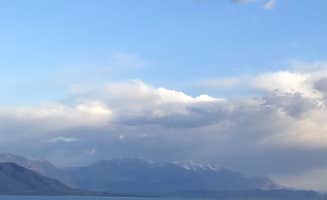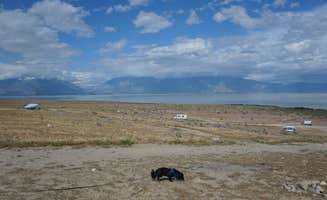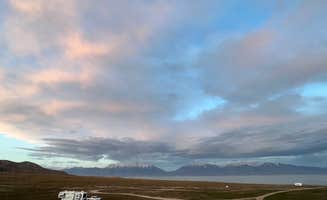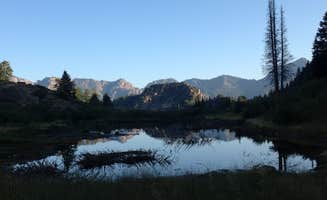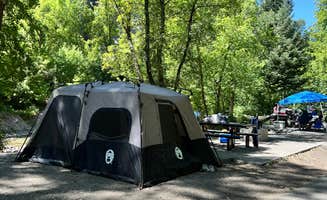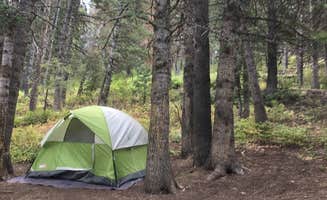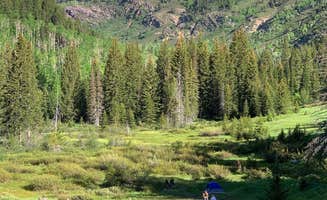Dispersed camping areas near Stockton, Utah range in elevation from around 4,300 feet in the lake basins to 7,000+ feet in the surrounding mountains. The region experiences dramatic temperature swings, with summer days often reaching 95°F while dropping 30-40 degrees after sunset. Winter access becomes limited as many unmaintained roads become impassable due to snow and mud conditions from December through March.
What to do
Mountain biking access: Several areas near White Rocks Dispersed Camping provide suitable terrain for intermediate riders, with routes ranging from 3-8 miles through varied desert terrain. "I drove out to watch the meteor shower and photograph the milky way. It's a very quiet area and scenery is beautiful," reports one camper who enjoyed the natural features.
Rock exploration: The rock formations at White Rocks offer climbing and exploration opportunities for all skill levels, with small caves scattered throughout. "The campsites themselves were beautiful, there's a massive rock you can climb with small caves for exploring. I've heard some people camp in the caves which sounds like my personal h*ll but if that's your thing the caves are accessible for that."
Overnight astronomy: The dark skies away from urban light pollution create prime conditions for stargazing, especially at Squaw Peak Road Dispersed sites which sit at higher elevations. "We stayed mid week and were the only people on the Mtn. Didn't have to go all the way to the point given by app," notes one camper who found solitude for night sky viewing.
What campers like
Seasonal timing: Spring and fall provide the most comfortable camping conditions, with fewer biting insects than summer months. "Great for cooler weather... We had the place to ourselves and had no issues finding it. Great views and a fun place to hang out alone in the desert," notes a visitor to Seven Mile Pass.
Wildlife viewing: Early mornings offer opportunities to spot pronghorn antelope and various bird species in the lower elevations. "Stayed for 1 night. Very quiet and private. I imagine if during the busy season this place would not be a great place to stay but the last week of April was not busy and it was very quiet," reports a camper at Horseshoe Knoll Dispersed Camping.
Solitude options: For those seeking complete isolation, the less-developed sites away from main roads provide true backcountry experiences. "We camped towards to the top. It had plenty of room for tents amongst the trees and in the field," shares a Squaw Peak Road visitor, highlighting the availability of secluded spots.
What you should know
Road conditions: Access roads deteriorate significantly after rainfall, with several requiring high-clearance vehicles year-round. "Getting here can be challenging, very steep incline, tight corners, and some spots have bumpy dirt roads. Perfect for tent camping and small trailers, spots are not big enough for bigger RVs and trailers," warns a Squaw Peak Road camper.
Seasonal insect populations: Biting gnats and mosquitoes become problematic from late spring through summer, particularly near water sources. "So many bugs it was awful, the mosquitoes ate us and our dogs even with bug repellents. The area was pretty flat it looked like on the left, but we had to go to the right as the left was full when we arrived."
Dispersed site identification: First-time visitors often struggle to identify established camping areas. At Eagle Mountain Dispersed, "This is BLM. A couple of different camping sites. Most have fire rings but no water or bathrooms. You will need a 4x4 with high clearance to get up the mountain (the road is rough)."
Tips for camping with families
Spring visits: Early spring (April-May) offers moderate temperatures and wildflower blooms without summer's extreme heat. "My young son loved the nearby spring, it was very mushy but not horrible in some spots!" shares a Horseshoe Knoll visitor who found child-friendly natural features.
Site selection: Choose established sites with existing fire rings for safety and convenience with children. "We had a great time at the top with beautiful views and quiet. Nobody else around. OHV area too," notes a camper at Eagle Mountain who found suitable family camping space.
Pack extra water: The arid climate requires at least 1.5 gallons per person per day for hydration and basic hygiene. "There are no hookups or services. This is really just a spot of BLM land that has some fairly level sites cleared," emphasizes the importance of self-sufficiency at these rustic camping areas near Stockton.
Tips from RVers
Site leveling: Most primitive sites near Stockton require significant leveling for RVs, with wooden blocks or leveling systems recommended. At Miners Canyon BLM, "With 5th wheel, took a couple sites before we were happy. Landed with large windows facing lake, lovely."
Road reconnaissance: RVers should scout roads before attempting access with larger rigs, especially at higher elevations. "It is a dirt road to get there and a little bumpy... We turned in and took one of the first sites though there were a lot of RVs further down."
Weekend crowding: Holiday and summer weekends see significant increases in OHV traffic and noise levels around rustic camping sites. "Maverick gas station about 5 Miles'ish down the road has free dump station," provides valuable infrastructure information for RVers needing services while boondocking near Stockton.





